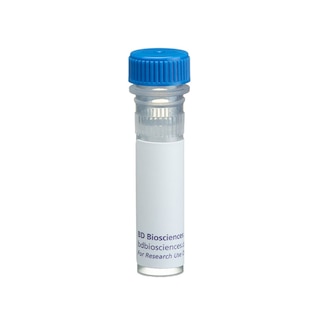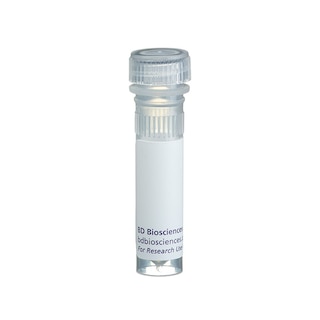-
Reagents
- Flow Cytometry Reagents
-
Western Blotting and Molecular Reagents
- Immunoassay Reagents
-
Single-Cell Multiomics Reagents
- BD® OMICS-Guard Sample Preservation Buffer
- BD® AbSeq Assay
- BD® Single-Cell Multiplexing Kit
- BD Rhapsody™ ATAC-Seq Assays
- BD Rhapsody™ Whole Transcriptome Analysis (WTA) Amplification Kit
- BD Rhapsody™ TCR/BCR Next Multiomic Assays
- BD Rhapsody™ Targeted mRNA Kits
- BD Rhapsody™ Accessory Kits
- BD® OMICS-One Protein Panels
- BD OMICS-One™ WTA Next Assay
-
Functional Assays
-
Microscopy and Imaging Reagents
-
Cell Preparation and Separation Reagents
Old Browser
This page has been recently translated and is available in French now.
Looks like you're visiting us from {countryName}.
Would you like to stay on the current location site or be switched to your location?
BD Pharmingen™ Purified Mouse Anti-Human c-erbB-3
Clone RTJ.1 (RUO)

Immunohistochemical staining of human lung cancer for C-erbB-3. The formalin-fixed paraffin embedded sections of human lung cancer were stained with either Purified Mouse IgM Isotype Control (Cat. No. 557275; Left Image) or Purified Mouse Anti-Human c-erbB-3 antibody (Cat. No. 554208; Right Image). A three-step staining procedure that employs a Biotin Goat Anti-Mouse Immunoglobulin (Cat. No. 550337), Streptavidin-Horseradish Peroxidase (HRP) (Cat. No.550946), and the DAB Substrate Kit (Cat. No. 550880) was used to develop the primary staining reagents. Original magnification: 20×.

Immunohistochemical staining of human lung cancer for C-erbB-3. The formalin-fixed paraffin embedded sections of human lung cancer were stained with either Purified Mouse IgM Isotype Control (Cat. No. 557275; Left Image) or Purified Mouse Anti-Human c-erbB-3 antibody (Cat. No. 554208; Right Image). A three-step staining procedure that employs a Biotin Goat Anti-Mouse Immunoglobulin (Cat. No. 550337), Streptavidin-Horseradish Peroxidase (HRP) (Cat. No.550946), and the DAB Substrate Kit (Cat. No. 550880) was used to develop the primary staining reagents. Original magnification: 20×.



Immunohistochemical staining of human lung cancer for C-erbB-3. The formalin-fixed paraffin embedded sections of human lung cancer were stained with either Purified Mouse IgM Isotype Control (Cat. No. 557275; Left Image) or Purified Mouse Anti-Human c-erbB-3 antibody (Cat. No. 554208; Right Image). A three-step staining procedure that employs a Biotin Goat Anti-Mouse Immunoglobulin (Cat. No. 550337), Streptavidin-Horseradish Peroxidase (HRP) (Cat. No.550946), and the DAB Substrate Kit (Cat. No. 550880) was used to develop the primary staining reagents. Original magnification: 20×.
Immunohistochemical staining of human lung cancer for C-erbB-3. The formalin-fixed paraffin embedded sections of human lung cancer were stained with either Purified Mouse IgM Isotype Control (Cat. No. 557275; Left Image) or Purified Mouse Anti-Human c-erbB-3 antibody (Cat. No. 554208; Right Image). A three-step staining procedure that employs a Biotin Goat Anti-Mouse Immunoglobulin (Cat. No. 550337), Streptavidin-Horseradish Peroxidase (HRP) (Cat. No.550946), and the DAB Substrate Kit (Cat. No. 550880) was used to develop the primary staining reagents. Original magnification: 20×.

Immunohistochemical staining of human lung cancer for C-erbB-3. The formalin-fixed paraffin embedded sections of human lung cancer were stained with either Purified Mouse IgM Isotype Control (Cat. No. 557275; Left Image) or Purified Mouse Anti-Human c-erbB-3 antibody (Cat. No. 554208; Right Image). A three-step staining procedure that employs a Biotin Goat Anti-Mouse Immunoglobulin (Cat. No. 550337), Streptavidin-Horseradish Peroxidase (HRP) (Cat. No.550946), and the DAB Substrate Kit (Cat. No. 550880) was used to develop the primary staining reagents. Original magnification: 20×.

Immunohistochemical staining of human lung cancer for C-erbB-3. The formalin-fixed paraffin embedded sections of human lung cancer were stained with either Purified Mouse IgM Isotype Control (Cat. No. 557275; Left Image) or Purified Mouse Anti-Human c-erbB-3 antibody (Cat. No. 554208; Right Image). A three-step staining procedure that employs a Biotin Goat Anti-Mouse Immunoglobulin (Cat. No. 550337), Streptavidin-Horseradish Peroxidase (HRP) (Cat. No.550946), and the DAB Substrate Kit (Cat. No. 550880) was used to develop the primary staining reagents. Original magnification: 20×.




Regulatory Status Legend
Any use of products other than the permitted use without the express written authorization of Becton, Dickinson and Company is strictly prohibited.
Preparation And Storage
Product Notices
- An isotype control should be used at the same concentration as the antibody of interest.
- Caution: Sodium azide yields highly toxic hydrazoic acid under acidic conditions. Dilute azide compounds in running water before discarding to avoid accumulation of potentially explosive deposits in plumbing.
- Please refer to www.bdbiosciences.com/us/s/resources for technical protocols.
- Since applications vary, each investigator should titrate the reagent to obtain optimal results.
- Sodium azide is a reversible inhibitor of oxidative metabolism; therefore, antibody preparations containing this preservative agent must not be used in cell cultures nor injected into animals. Sodium azide may be removed by washing stained cells or plate-bound antibody or dialyzing soluble antibody in sodium azide-free buffer. Since endotoxin may also affect the results of functional studies, we recommend the NA/LE (No Azide/Low Endotoxin) antibody format, if available, for in vitro and in vivo use.
Companion Products




C-erbB-3, a glycoprotein of 160 kD, is a member of the type 1 growth factor receptor subfamily which also includes c-erbB-2 (HER2/neu), c-erbB-4 and the epidermal growth factor receptor (EGFR, c-erbB-1). Members of this receptor subfamily mediate the proliferation and differentiation of normal cells. They have a common structure consisting of an extracellular domain, a transmembrane region, and a cytoplasmic sequence. The extracellular regions contain two cysteine-rich domains, and the intracellular regions have sequence homology to known tyrosine kinases. C-erbB-3 is expressed in tissues from the digestive, urinary and respiratory tracts, the circulatory system, and female and male reproductive organs. c-erb B-3 is undetectable in hematopoietic tissue and cell lines derived from hematopoietic tumors. Cellular localization has been described as cytoplasmic and/or membrane, and nuclear. The level and pattern of c-erbB-3 expression varies widely in both normal and tumor tissues.
Clone RTJ.1 recognizes an epitope in the cytoplasmic domain of the human c-erbB-3 protein. It does not react with the EGF receptor or c-erbB-2. A synthetic peptide (referred to as 49.3) from the cytoplasmic domain of human c-erbB-3 protein was used as immunogen. RTJ.1 identifies a 160 kD band corresponding to c-erbB-3 by western blot analysis and immunoprecipitation. RTJ.1 may also react with two additional, unidentified higher molecular weight bands by immunoprecipitation and western blot analysis. These bands are likely to be non-specific, as they were not detected with a polyclonal antibody raised against the same immunogen. Because two additional bands were observed, the specificity of RTJ.1 for immunohistochemistry was analyzed by comparing staining results to those obtained using three polyclonal antibodies also raised against 49.3. Identical staining results were obtained using RTJ.1 and all three polyclonal antibodies. These results validated the use of RTJ.1 for immunohistochemical analysis of c-erbB-3.
Development References (5)
-
Carraway KL 3rd, Cantley LC. A neu acquaintance for erbB3 and erbB4: a role for receptor heterodimerization in growth signaling. Cell. 1994; 78(1):5-8. (Biology). View Reference
-
In: Hesketh R. The Oncogene Handbook. New York: Academic Press; 1994:485-509.
-
Prigent SA, Lemoine NR, Hughes CM, Plowman GD, Selden C, Gullick WJ. Expression of the c-erbB-3 protein in normal human adult and fetal tissues. Oncogene. 1992; 7(7):1273-1278. (Biology). View Reference
-
Rajkumar T, Gooden CS, Lemoine NR, Gullick WJ, Goden CS. Expression of the c-erbB-3 protein in gastrointestinal tract tumours determined by monoclonal antibody RTJ1. J Pathol. 1993; 170(3):271-278. (Clone-specific: Immunohistochemistry, Immunoprecipitation, Western blot). View Reference
-
Sanidas EE, Filipe MI, Linehan J, et al. Expression of the c-erbB-3 gene product in gastric cancer. Int J Cancer. 1993; 54(6):935-940. (Clone-specific: Immunohistochemistry). View Reference
Please refer to Support Documents for Quality Certificates
Global - Refer to manufacturer's instructions for use and related User Manuals and Technical data sheets before using this products as described
Comparisons, where applicable, are made against older BD Technology, manual methods or are general performance claims. Comparisons are not made against non-BD technologies, unless otherwise noted.
Please refer to Support Documents for Quality Certificates
Global - Refer to manufacturer's instructions for use and related User Manuals and Technical data sheets before using this products as described
Comparisons, where applicable, are made against older BD Technology, manual methods or are general performance claims. Comparisons are not made against non-BD technologies, unless otherwise noted.
For Research Use Only. Not for use in diagnostic or therapeutic procedures.